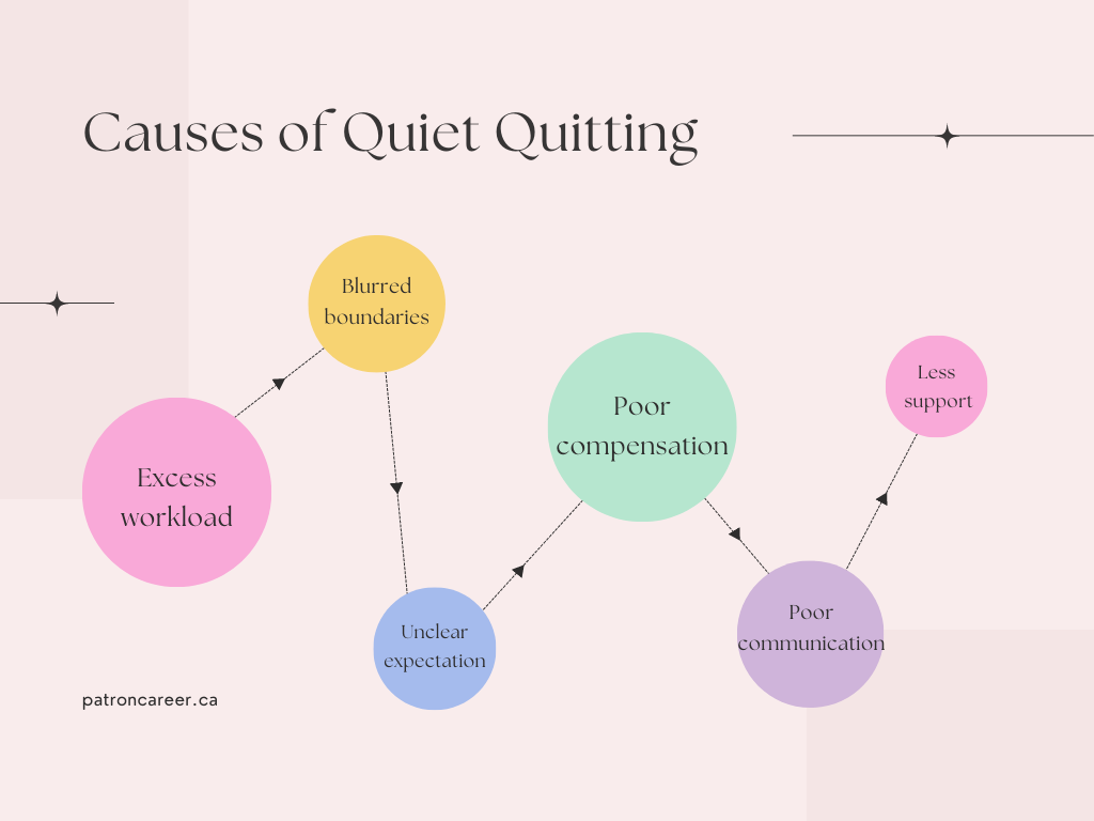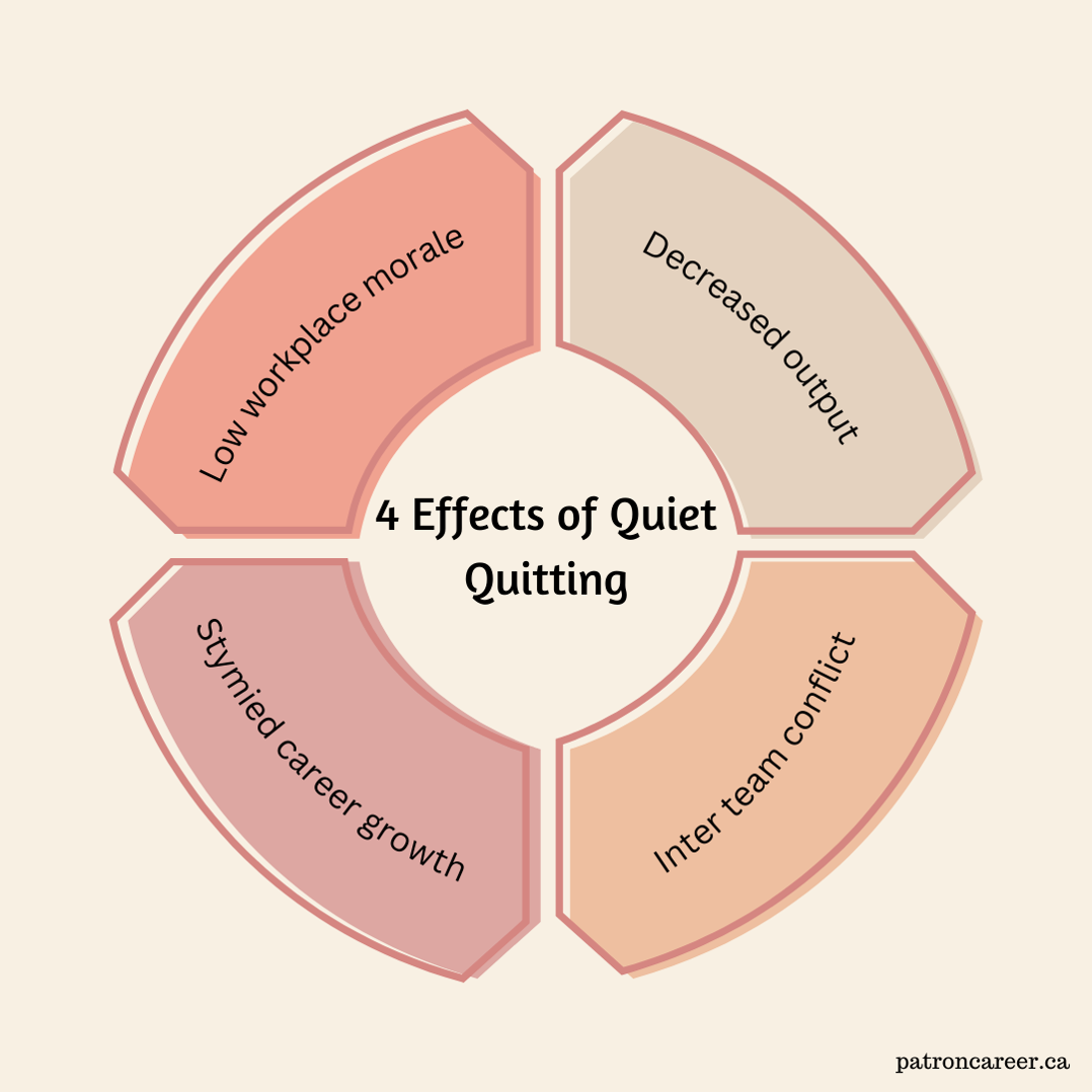
Internal Whistleblowing
04 August, 2023
Patron Career Staffing firmly believes in adopting a tailored approach to meet temporary and permanent recruitment needs. We safeguard the interest of our clients by finding such workers who are knowledgeable and reliable.
About UsNeed help? Make a Call
32 Dundas Street East Unit A, L5A1W2

Picture this: Employees are physically present but mentally drifting away, haunting the productivity and growth of your business. Prepare to untie the secrets of this silent spectre as we delve into the mysterious realm of disengagement and unveil the key to preventing its malicious influence at work.
Amid a bustling office, the sound of keyboards clacking and phones ringing might create an illusion of a thriving workforce. But lurking beneath this façade lies a silent opponent that can imperceptibly gnaw away at the very core of your company. Quiet Quitting, also known as "presenteeism," shrouds your employees in a cloak of indifference, concealing their disengagement and dissatisfaction. The consequences? Decreased productivity, a poisoned company culture, and an exodus of your most talented team members.
Today, we delve into a prevalent yet often overlooked workplace phenomenon called "Quiet Quitting." Employee disengagement can silently cripple productivity, morale, and ultimately, your company's success. In this blog, we'll explore the meaning of Quiet Quitting, its impact, and most importantly, strategies to prevent and combat it in your organization.
What is Quiet Quitting?
Quiet Quitting, also known as "presenteeism," refers to a situation where employees show up for work physically but mentally disengage from their tasks and the overall work environment. These disengaged employees may appear productive on the surface, but they lack motivation, enthusiasm, and a sense of ownership in their roles. The result is a decline in performance, creativity, and a negative influence on their colleagues.
Why Quiet Quitting Happens: Understanding the Root Causes
Quiet Quitting is not an isolated occurrence; rather, it stems from a combination of factors that contribute to employee disengagement. Understanding these root causes is essential for employers to address the issue effectively. Here are some common reasons why Quiet Quitting happens in the workplace:

1. Lack of Recognition and Appreciation: When employees feel that their efforts and contributions go unnoticed or unappreciated, they may lose their motivation to invest their full potential in their work.
2. Inadequate Career Growth Opportunities: The absence of clear career advancement paths and professional development opportunities can lead to feelings of stagnation and disillusionment among employees.
3. Poor Work-Life Balance: When employees are constantly overwhelmed by long working hours, tight deadlines, and lack of flexibility, it can take a toll on their well-being and commitment to the job.
4. Ineffective Leadership and Management: Unsupportive or disengaged leaders can create a toxic work environment where employees feel undervalued and disconnected from the company's vision and goals.
5. Job Dissatisfaction: Employees may experience disengagement if they find their job tasks monotonous, unchallenging, or not aligned with their skills and interests.
6. Inadequate Resources and Support: A lack of necessary tools, resources, and support to perform their duties efficiently can lead to frustration and disengagement.
7. Workplace Conflict and Negative Culture: A hostile or unsupportive work culture can negatively impact employee morale, causing them to withdraw from active participation.
8. Personal Issues and Burnout: Employees dealing with personal challenges, stress, or burnout may find it challenging to stay focused and engaged in their roles.
9. Feeling Undervalued and undercompensated: When employees feel they are not adequately compensated for their efforts or that their work is undervalued, it can erode their motivation to perform at their best.
10. Lack of Purpose and Alignment: Employees who do not connect with the company's mission and values may struggle to find meaning and purpose in their work, leading to disengagement.
Also Read: How Canada purports Workplace Equality through the Employment Equity Act
The Impact of Quiet Quitting
Recognizing the signs and consequences of Quiet Quitting is crucial for employers to address the issue proactively. Some of the common impacts include:

1. Reduced productivity and efficiency.
2. Lowered employee morale and team dynamics.
3. Increased absenteeism and higher turnover rates.
4. Compromised quality of work and customer service.
5. Decreased innovation and creative problem-solving.
How to Prevent Quiet Quitting
As an employer, you have the power to create a positive work environment that fosters employee engagement and satisfaction. Here are some effective strategies to prevent Quiet Quitting:
1. Promote Open Communication: Encourage regular feedback sessions and create an open- door policy to allow employees to express their concerns and ideas freely.
2. Provide Growth Opportunities: Offer training and development programs to help employees advance in their careers and expand their skills.
3. Recognize and Reward: Acknowledge employees' achievements and contributions through praise, rewards, and recognition programs.
4. Foster Work-Life Balance: Promote a healthy work-life balance by implementing flexible work hours and remote work options when possible.
5. Lead by Example: Cultivate a positive and engaged company culture starting from the top. Leaders who demonstrate passion and commitment to their work inspire their teams to do the same.
Combatting Quiet Quitting
In case Quiet Quitting has already taken root in your organization, it's never too late to address the issue and revitalize your workplace. Consider these strategies to combat Quiet Quitting:
1. Conduct Employee Surveys: Gather anonymous feedback through surveys to understand the root causes of disengagement and dissatisfaction within your workforce.
2. Implement Employee Assistance Programs: Offer counselling and support services to employees facing personal or professional challenges.
3. Reevaluate Job Design: Analyze job roles to ensure they align with employees' skills and interests, preventing feelings of stagnation or dissatisfaction.
4. Encourage Team-Building Activities: Organize team-building events and activities to foster stronger connections and a sense of belonging among team members.
5. Revamp Recognition Programs: Make sure your recognition initiatives are meaningful and inclusive, acknowledging various types of contributions and efforts.
Pros and Cons of Quiet Quitting
Like any workplace phenomenon, Quiet Quitting has its pros and cons.
Pros:
1. May keep the employee physically present, reducing immediate disruption.
2. Provides an opportunity for employers to address and resolve underlying issues.
Cons:
1. Decreased productivity and performance levels.
2. Negative impact on team morale and overall company culture.
3. Increased likelihood of employee burnout and turnover.
Conclusion
As an employer, staying vigilant about Quiet Quitting is crucial for maintaining a highly engaged and motivated workforce. By recognizing the signs, preventing its occurrence, and taking action to combat it, you can create an environment where employees feel valued, productive, and inspired to contribute to the success of your organization. Remember, a workforce that is genuinely engaged is the driving force behind a thriving business.
